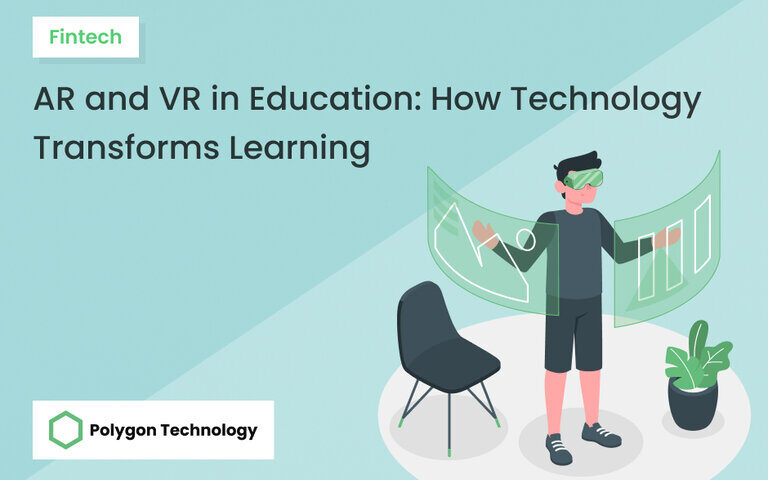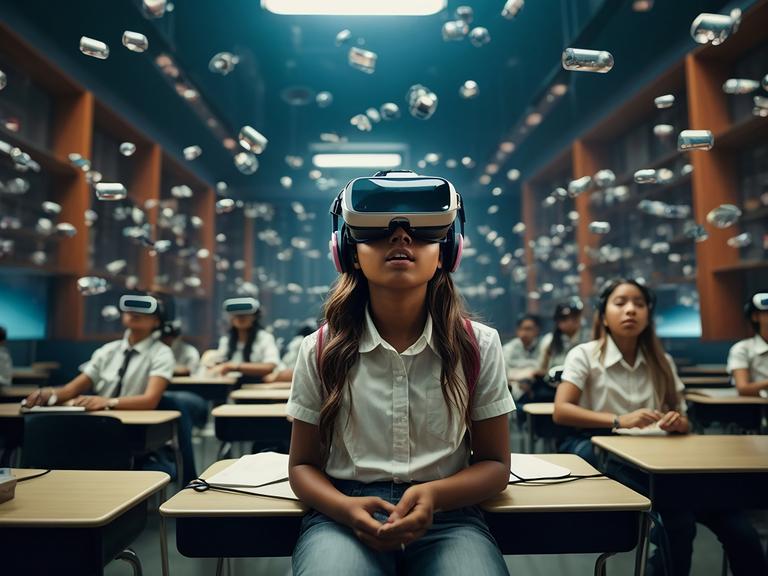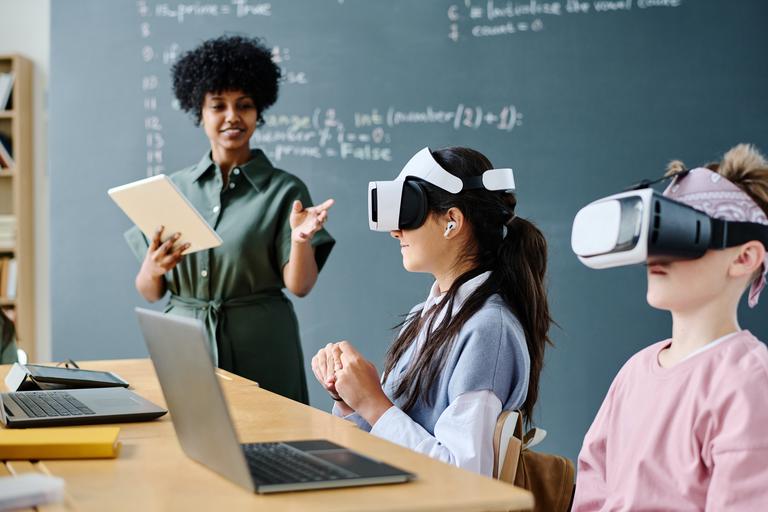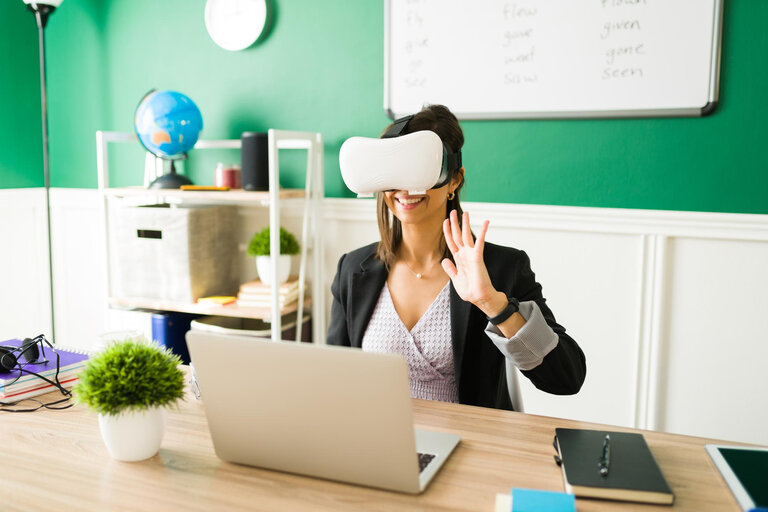
AR and VR in Education: How Technology Transforms Learning
AR and VR in Education: How Technology Transforms Learning

Md. Rabiul Alam Sarker
Rabiul Alam brings a blend of manual and automation expertise to the world of software testing. With a deep understanding of the entire testing life-cycle for dynamic web and mobile applications. His experience spans popular testing frameworks like Selenium, TestNG, and Appium. Additionally, he possesses hands-on knowledge of DevOps tools like Docker, ELK stack, and CI/CD pipelines.

Md. Asad Chowdhury Dipu

Modern education defines how we exchange knowledge with each other. Now, teaching and learning are undergoing a profound transformation. It is all thanks to the ever-growing significance of information and communication technologies.
Among these technological advancements, augmented reality (AR) and virtual reality (VR) have become game-changers in education. These immersive technologies are remodeling how students engage with complex concepts and diverse subject matters.
Today, we will explore how AR and VR in education are reshaping the learning landscape. You will understand how these technologies embrace cultural diversity across various disciplines.
What is Augmented Reality (AR)?
Augmented Reality (AR) connects virtual elements with the real-world environment. This groundbreaking technology provides a more interactive experience by creating a digital layer to what we see around us.
AR works by using devices like smartphones or tablets to capture our surroundings through cameras and sensors. Afterward, these devices analyze the images and measure distances to understand the space. Once the environment is recognized, AR adds virtual information like images, sounds, videos, or graphics to enhance what we see.
Augmented reality in education opens up endless possibilities. For instance, students can learn about the solar system by incorporating AR and VR in education. Teachers can do the following without leaving the classroom by using AR.
- Bring textbook illustrations to life
- Conduct virtual science experiments
- Take students on virtual field trips
- Create interactive lessons and engaging activities

The Role of AR in Education
Augmented Reality (AR) is reshaping the traditional way of education. With AR, learning becomes more immersive and engaging. So, how is AR applied in education? AR is enhancing teaching methods and student understanding in the following ways.
Teaching Geometry
One area where AR shines is in geometry teaching. Concepts like perimeters, areas, and diameters come to life through interactive AR experiences. As a result, abstract ideas become tangible and easier to grasp.
Giving Dynamic and Interactive Presentations
Teachers can seamlessly integrate AR elements into their presentations. With dynamic and interactive presentations, it will be easier to make students active participants in the learning process. Students will be more attentive while visualizing complex concepts or graphics.
Prototyping and Modeling
In prototyping, AR takes learning to a whole new level. Students can utilize AR for CAD modeling. This will certainly foster engagement and creativity. Moreover, AR proves invaluable in teaching UI-UX design. It can provide hands-on experiences that simulate real-world scenarios.
Training and Learning
AR enriches training programs by creating immersive simulations. It can enhance knowledge retention and skill development. These activities receive a significant boost from AR, whether they are for companies, businesses, universities, or schools.
Research and Development
AR is not limited to the classroom; it is a vital tool in research and development. Both companies and universities leverage AR technology to drive innovation. With AR, they can explore new frontiers in various fields effortlessly.
Benefits of AR in the Education Sector
Augmented reality in education generates a more interactive, engaging, and effective learning environment. By incorporating AR and VR in education, educators can make students active participants while they are teaching.
Although AR offers plenty of benefits to the education sector, we can clearly notice the following ones.
- Enhanced student engagement: AR makes learning more interactive and captivating. It creates enthusiasm among students. So, they become eager to participate in educational programs.
- Improved understanding of complex concepts: AR tangibly represents abstract ideas. Hence, students can grasp difficult concepts more easily.
- Real-world application: AR bridges the gap between theoretical knowledge and real-world application. It lets students see how concepts relate to practical scenarios.
- Increased retention rates: The immersive nature of AR experiences enhances memory retention. This nature leads to better long-term learning outcomes.
- Accessibility and inclusivity: AR technology can accommodate diverse learning needs. Thus, it can make education more accessible to students with disabilities or learning difficulties.
- Collaborative learning opportunities: AR fosters collaboration among students as they work together to solve problems and explore virtual environments.
- Bridging geographical barriers: AR enables remote learning experiences. It connects students and educators across different locations for collaborative projects and virtual field trips.
- Preparation for future technologies: By incorporating AR into education, students gain valuable skills and familiarity with emerging technologies. Ultimately, AR can prepare them for the digital workforce of tomorrow.
What is Virtual Reality (VR)?
VR or Virtual Reality, immerses users in computer-generated simulations and alters their perceptions of reality. VR creates simulated scenes and objects that appear real. This is how it transports individuals into alternative realities through specialized devices, like glasses or helmets.
In terms of education, VR is revolutionizing the learning experience. It provides immersive environments for exploring complex subjects. Hence, students can engage with educational content in a way that feels tangible and real. Ultimately, VR can enhance comprehension and retention.
For some reason, VR has proven to be a powerful tool for promoting cultural understanding. It increases the percentage of acceptance in diverse classrooms. By experiencing virtual environments, students can develop empathy, respect, and appreciation for cultural diversity.

The Role of VR in Education
Virtual Reality (VR) is playing a transformative role in the education sector. It empowers both educators and students by reshaping traditional teaching methods. And VR is doing this in the following ways.
Progressing Elementary and Higher Education
Utilizing technology to enhance learning processes is crucial in this modern age. In this case, VR acts as a natural progression towards achieving excellence in elementary and higher education. Students dive into virtual environments through virtual reality. This way, they enjoy unparalleled opportunities for interactive and engaging learning experiences.
Accelerating Virtual Education
Before the COVID-19 pandemic, education primarily relied on face-to-face interactions in physical classrooms. However, the shift towards virtual education spaces has accelerated. Educators have started using VR as a tool for content delivery and collaborative learning.
Breaking Geographical Barriers
VR enables teachers to transcend geographical barriers. Therefore, they can engage with students in immersive virtual environments. Through VR, educators can facilitate the exploration of complex subjects. Plus, using VR in education fosters collaborative knowledge-building among students.
Benefits of VR in the Education Sector
Educators have realized the benefits of using virtual reality in education. By incorporating VR into classrooms, educators can create dynamic and engaging learning environments.
VR inspires curiosity, fosters collaboration, and promotes academic success in the following ways.
- Enhanced sense of place: VR creates immersive environments that transport students to different locations. So, they can experience historical events, explore distant places, and gain a deeper understanding of various subjects.
- Scalable learning experiences: Using VRs, students can engage in practical, hands-on learning activities. This may not be feasible in traditional classroom settings. This is how VR provides opportunities for scalable learning experiences.
- Experiential learning: With VR goggles, students can actively participate in simulations and experiments. They can apply theoretical knowledge to realistic scenarios. So, VR can facilitate experiential learning.
- Visual learning: Visual learners can make the most of VR educational technologies. They can experience interactive visualizations of complex concepts. Also, students can replace traditional textbooks with VR simulations to visualize abstract ideas. This makes learning more engaging and comprehensible.
- Immersive storytelling: VR gives educators immersive storytelling experiences. Virtual stories can captivate students’ attention. Hence, they get a better understanding of narrative-driven subjects like literature and history.
- Accessibility and inclusivity: VR technology accommodates diverse learning needs. It provides accessible learning experiences for students with disabilities or learning difficulties. It creates inclusive environments where all students can participate and succeed.
- Remote collaboration: VR facilitates remote collaboration among students and educators. It enables seamless communication and collaboration on projects and assignments, regardless of geographical location.
AR and VR in Education: How They Are Changing the Traditional Way of Learning
A particular institute conducted an exhaustive meta-analysis of experiential learning in 89 studies. Their analysis revealed that experiential learning outcomes surpass traditional learning outcomes by nearly 50%. Through experiential learning, students enhance their cognitive and social skills.
So, AR and VR in education are exceptionally potent for changing the traditional learning method. Mostly, these technologies are modernizing traditional education in the following 8 ways.
Expanding Interactive Experiences
AR and VR technologies revolutionize learning across various fields and disciplines. Extended Reality (XR) enhances accessibility in science education. It allows students to conduct experiments safely and repeatedly in a digital environment. Instead of merely observing, they can actively participate in specific programs. This can be either playing in an orchestra or responding to emergencies in simulated environments.
Here are some examples of VR and AR interactive experiences:
- Immersive learning activities to help build skills.
- Virtual field trips for students from K-12.
- Making learning accessible for students with disabilities.
- Making 3-D models to scale for architects and engineers.
- Providing field training for construction and advanced manufacturing.
- Training for healthcare professionals in high-risk situations.
- Teaching science students laboratory research methods.
Creating Opportunities for Hands-On Experiences
AR and VR technology provides practical solutions for hands-on learning experiences. Students can absorb knowledge intellectually through tactile engagement. Plus, they can engage their senses, leading to deeper understanding and retention.
With AR and VR, individuals can access hands-on skill training and explore various career paths virtually. This accessibility fosters self-discovery and career exploration.
Increasing Enjoyment in Activities
With AR and VR technology, learning becomes an immersive adventure that goes beyond textbooks. Students can explore their interests in virtual worlds. What’s more, they can even do mundane tasks. For instance, they can memorize multiplication tables or study civics excitingly and interactively.
On top of that, cloud-based AR apps enable students to take their learning on the go. With these apps, students can engage with real-time information as they discover new places and concepts.
Overcoming Barriers to Language
AR and VR technologies break down language barriers. They ensure equitable access to education for all students. Often, they come up with language translation features. Therefore, students can understand and participate in lessons regardless of their native language.
For students learning a foreign language, immersive VR scenarios provide authentic practice opportunities. They can immerse themselves in various scenarios. For example, eating food in a French restaurant or conducting a job interview in English. Augmented and virtual reality can enhance language proficiency in authentic settings.
Overcoming Barriers to Experience
Imagine witnessing the Aurora Borealis or observing a lion pride hunt in the African savanna—all from your classroom. AR and VR in education take students into immersive environments. They can provide firsthand experiences that were once impractical or impossible.
These experiential learning opportunities expand intellectual intelligence among students. Additionally, experimental learning fosters emotional intelligence. It promotes deeper critical thinking and understanding.
Overcoming Barriers to Financial
Most of the time, financial constraints limit schools’ ability to provide enriching learning experiences. However, augmented and virtual reality in education brings these experiences directly into the classroom. So, both schools and students can overcome financial barriers.
While VR and AR equipment may already be available in classrooms, utilization rates remain low. Educators should create immersive learning experiences immediately by harnessing existing technology. This way, they can enrich students’ educational journey from day one.
Enhancing Accessibility for All
Augmented and virtual reality in education are breaking down barriers and fostering inclusivity. Thanks to advancements in VR and AR technology, students of all abilities can now engage in immersive learning experiences tailored to their needs.
VR and AR empower learners to overcome challenges and succeed academically. These technologies accommodate diverse learning styles. They make sure every student can participate and learn effectively. For that purpose, they have been –
Offering low-stress environments for students with learning disabilities.
Providing therapeutic benefits for users with health impairments.
Providing Spatial References
Often, traditional teaching methods struggle to convey complex spatial concepts effectively. AR and VR technology can offer immersive experiences that bring abstract concepts to life. This is effective for revolutionizing spatial learning.
For example, Belle2VR enables students to explore the subatomic world through interactive VR visualizations. It allows them to witness particle collisions and manipulate transparency levels for a deeper understanding.
Similarly, students can take a virtual tour of the universe with the Virtual Reality Universe Project. It provides real-time exploration of galaxies, planets, and black holes based on contemporary astrophysical data.

Common Uses of AR and VR in Education
Educational institutions should integrate technologies into educational practices more. This can enhance student engagement, comprehension, and skill development. Ultimately, this will lead to improved learning outcomes.
Currently, we can observe the following uses of AR and VR in education.
1. Virtual Lectures and Classroom Experiences
Leading institutions like Harvard University are adopting VR technology to enhance learning experiences. Through immersive 3D lectures, students can participate in courses like Computer Science 50 (CS50) from their homes. This approach not only makes learning more engaging but also expands access to education for students worldwide.
2. Interactive Learning Scenarios
VR and AR transform provide immersive educational scenarios. Students can engage in interactive learning activities that bring subjects to life. Plus, they can take virtual field trips and conduct hazard-free experiments. These hands-on experiences foster deeper understanding and retention of concepts.
3. Enhancing Retention Rates in Online Learning
Research has shown that humans process visuals much faster than text. This makes immersive scenarios an effective tool for improving retention rates. Although online learning often faces challenges with retention rates, VR and AR offer a solution. Subjects like science and engineering training can be particularly enhanced through VR and AR.
4. AR and VR for Immersive Medical Education
In the medical field, immersive learning with AR and VR technology is invaluable. Surgeons can practice complex procedures on virtual 3D models. This is an excellent way to gain hands-on experience without the need for live patients.
5. Experiential Learning with AR and VR
AR and VR provide hands-on experiences that are particularly beneficial for technical subjects. Students can interact with virtual environments and see the outcomes of their actions firsthand. This reflective learning enhances conceptual understanding. So, complex topics become more accessible and engaging.
6. All-Inclusive eLearning Solution
Augmented and Virtual Reality provides comprehensive eLearning solutions that suit different learning styles. Educators can deliver lessons in innovative ways. So, intricate concepts become easier to understand and digest.
Final Verdict on AR and VR in Education
Clearly, AR and VR have significantly transformed the traditional learning method. Now, students can engage with complex concepts and diverse subject matters, all thanks to AR and VR in education. We have also seen that these technologies facilitate students’ exposure to different cultures and perspectives. This way, they are creating inclusive and diverse educational environments.
As we look to the future, it is imperative to keep promoting the integration of virtual and augmented reality into curricula. This is the ultimate way to create a more engaging, inclusive, and effective learning experience for all.